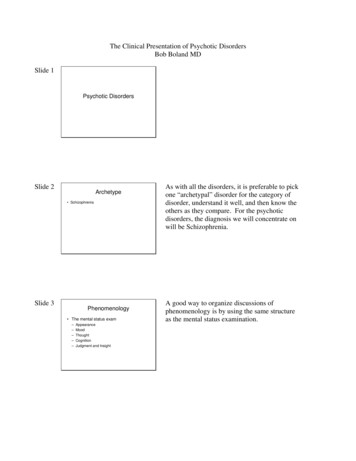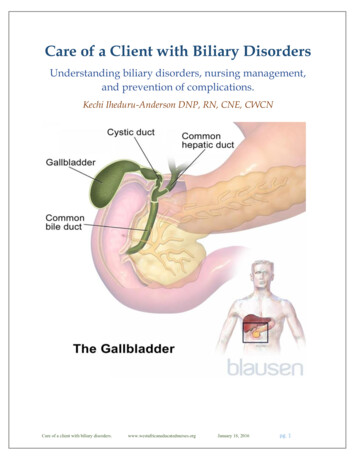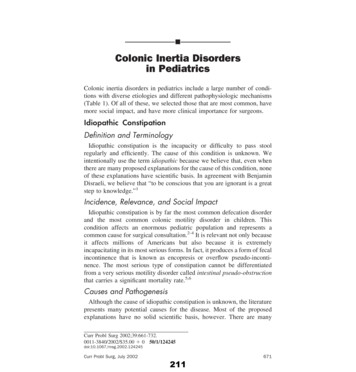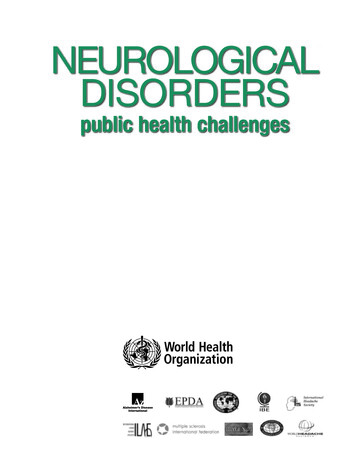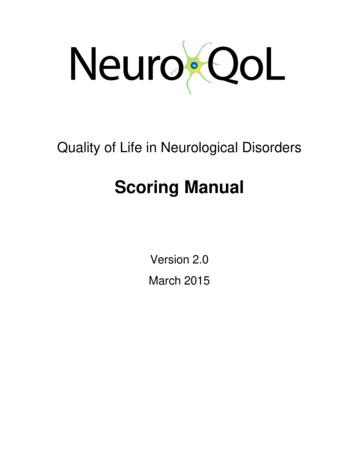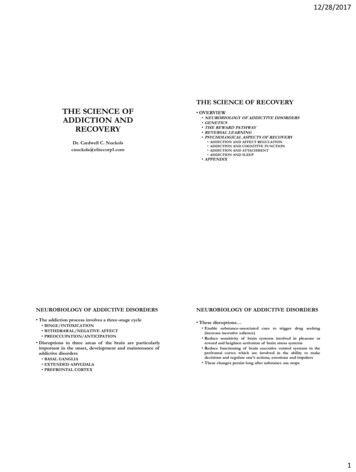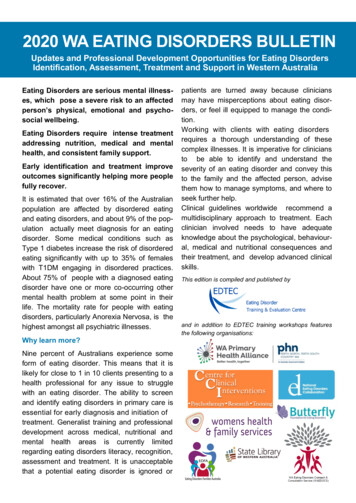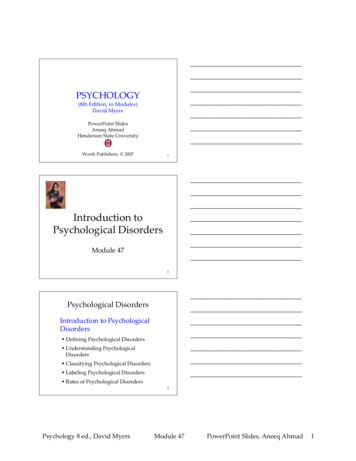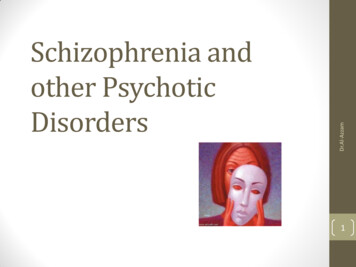
Transcription
Dr.Al-AzzamSchizophrenia andother PsychoticDisorders1
Discuss the concepts of schizophrenia and related psychoticdisorders. Identify etiological implications in the development of thesedisorders. Describe various types of schizophrenia and related psychoticdisorders. Identify symptomatology associated with these disorders anduse this information in client assessment. Nursing processDr.Al-AzzamObjectives2
Formulate nursing diagnoses and outcomes of care for clientswith schizophrenia and other psychotic disorders. Identify topics for client and family teaching relevant toschizophrenia and other psychotic disorders. Describe appropriate nursing interventions for behaviorsassociated with these disorders. Describe relevant criteria for evaluating nursing care of clientswith schizophrenia and related psychotic disorders. Discuss various modalities relevant to treatment ofschizophrenia and related psychotic disorders.Dr.Al-AzzamCont;3
Schizophrenia schizophrenia probably causes more lengthy hospitalizationsmore chaos in family lifemore exorbitant costs to individuals and governmentsand more fears than any other. Potential for suicide is a major concern among patients withschizophrenia. Approximately 10 percent of patients with schizophrenia dieby suicide. Other studies estimate evidence of suicidal ideation inindividuals with schizophrenia to be in the range of 40 to 55percent and attempted suicide to be in the range of 20 to 50percent (Addington, 2006).Dr.Al-Azzam Schizophrenia is responsible for suffering in society because:4
Schizophrenia causes disturbances in thought processes,perception, and affect invariably result in a severedeterioration of social and occupational functioning. Symptoms generally appear in late adolescence or earlyadulthood, although they may occur in middle or late adultlife. Some studies have indicated that symptoms occur earlier inmen than in women.Dr.Al-AzzamCont;5
Cont; Positive symptom: (known by their presence) Negative symptom: (characterized by absence) social withdrawal, lack of affect, andreduced motivation.Dr.Al-Azzam delusions, hallucinations, abnormalmovements, or thought disorders.6
Phases of Symptoms Development indifferent to social relationships having a very limited range of emotional experience andexpression. They do not enjoy close relationships Prefer to be “loners.” They appear cold and aloof. Not all individuals who demonstrate the characteristics ofschizoid personality will progress to schizophrenia. However, many individuals with schizophrenia show evidenceof having had these characteristics in the premorbid condition.Dr.Al-Azzam Phase I: The Schizoid Personality. The DSM-IV-TR (APA, 2000) describes individuals in this phaseas7
Cont; social withdrawalimpairment in role functioningbehavior that is peculiar or eccentricneglect of personal hygiene and groomingblunted or inappropriate affectdisturbances in communicationbizarre ideasunusual perceptual experiencesand lack of initiative, interests, or energy. The length of this phase is highly variable, and may last formany years before deteriorating to the schizophrenic state.Dr.Al-Azzam Phase II: The Prodromal Phase. Characteristics of this phase include8
Phase III: Schizophrenia. In the active phase of the disorder,psychotic symptoms are prominent. Following are the DSM-IV-TR (APA, 2000) diagnostic criteriafor schizophrenia: Characteristic Symptoms: Two (or more) of the following,each present for a significant portion of time during a 1-monthperiod (or less if successfully treated): DelusionsHallucinationsDisorganized speech (e.g., frequent derailment or incoherence)Grossly disorganized or catatonic behaviorNegative symptoms (i.e., affective flattening, alogia,or avolition)Dr.Al-AzzamCont;9
Social/Occupational Dysfunction: For a significant portion of thetime since the onset of the disturbance, one or more major areas offunctioning— such as work, interpersonal relationships, or selfcare—are markedly below the level achieved before the onset (orwhen the onset is in childhood or adolescence, failure to achieveexpected level of interpersonal, academic, or occupationalachievement). Duration: Continuous signs of the disturbance persist for at least 6months. This 6-month period must include at least 1 month of symptoms (orless if successfully treated) that meet criterion 1 (i.e., active-phasesymptoms) may include periods of prodromal or residual symptoms. During these prodromal or residual periods, the signs of thedisturbance may be manifested by only negative symptoms or two ormore symptoms listed in criterion 1 present in an attenuated form(e.g., odd beliefs, unusual perceptual experiences).Dr.Al-AzzamCont; characteristics of the thirdphase10
Cont; Phase IV: Residual Phase. Schizophrenia is characterized by: A residual phase usually follows an active phase of the illness. Symptoms during the residual phase are similar to those ofthe prodromal phase, with flat affect and impairment in rolefunctioning being prominent. Residual impairment often increases between episodes ofactive psychosis.Dr.Al-Azzam periods of remission and exacerbation.11
Prognosis good premorbid adjustmentlater age at onsetFemale genderabrupt onset of symptoms precipitated by a stressful event (asopposed to gradual insidious onset of symptoms)associated mood disturbancebrief duration of active-phase symptomsgood interepisode functioningminimal residual symptomsabsence of structural brain abnormalitiesnormal neurological functioninga family history of mood disorder, and no family history ofschizophrenia (APA, 2000).Dr.Al-Azzam A return to full premorbid functioning is not common However, several factors have been associated with a more positiveprognosis:12
ETIOLOGICAL IMPLICATIONSDr.Al-Azzam Many psychiatric disorders are multifactorial (caused by theinteraction of external and genetic factors) and from thegenetic point of view very often polygenically determined.13
Studies show that relatives of individuals with schizophreniahave a much higher probability of developing the disease thandoes the general population. Whereas the lifetime risk for developing schizophrenia isabout 1 percent in most population studies, the siblings oroffspring of an identified client have a 5 to 10 percent risk ofdeveloping schizophrenia (Ho, Black & Andreasen, 2003).Dr.Al-AzzamGenetics14
The rate of schizophrenia among monozygotic (identical) twinsis four times that of dizygotic (fraternal) twins andapproximately 50 times that of the general population (Sadock& Sadock, 2003). Identical twins reared apart have the same rate ofdevelopment of the illness as do those reared together. Because in about half of the cases only one of a pair ofmonozygotic twins develops schizophrenia, some investigatorsbelieve environmental factors interact with genetic ones.Dr.Al-AzzamTwin Studies15
It was found that the children who were born of schizophrenicmothers were more likely to develop the illness than thecomparison control groups (Ho, Black, & Andreasen,2003). Studies also indicate that children born of nonschizophrenicparents, but reared by schizophrenic parents, do not seem tosuffer more often from schizophrenia than general controls.Dr.Al-AzzamAdoption Studies16
The Dopamine Hypothesis schizophrenia (or schizophrenia- like symptoms) may becaused by an excess of dopamine-dependent neuronal activityin the brain. The neuroleptics (e.g., chlorpromazine and haloperidol) lowerbrain levels of dopamine by blocking dopamine receptors,thus reducing the schizophrenic symptoms, including thoseinduced by amphetamines.Dr.Al-AzzamBiochemical Influences17
Cont;Dr.Al-Azzam Postmortem studies of schizophrenic brains have reported asignificant increase in the average number of dopaminereceptors in approximately two thirds of the brains studied.18
Physiological Influences high incidence of schizophrenia after prenatal exposure toinfluenza. an association has been found between viral infections of thecentral nervous system during childhood and adult-onsetschizophrenia.Dr.Al-Azzam Viral infection:19
Anatomical Abnormalities structural brain abnormalities have been observed inindividuals with schizophrenia. Ventricular enlargement and the sulci enlargement andcerebellar atrophy are also reported. possible decrease in cerebral and intracranial size in clientswith schizophrenia. Studies have also revealed a decrease in frontal lobe size, butthis has been less consistently replicated.Dr.Al-AzzamCont;20
Histological Changes A “disordering” or disarray of the pyramidal cells in the area ofthe hippocampus has been suggested. This disarray of cells has been compared to the normalalignment of the cells in the brains of clients without thedisorder. Some researchers have hypothesized that this alteration inhippocampal cells occurs during the second trimester ofpregnancy and may be related to an influenza virusencountered by the mother during this period. Further research is required to determine the possible linkbetween this birth defect and the development ofschizophrenia.Dr.Al-AzzamCont;21
Some studies have reported a link between schizophrenia andepilepsy (particularly temporal lobe) Huntington’s disease birth trauma head injury in adulthood alcohol abuse cerebral tumor (particularly in the limbic system) cerebrovascular accidents Systemic lupus erythematosus myxedema parkinsonism, and Wilson’s disease.Dr.Al-AzzamPhysical Conditions22
Early conceptualizations of schizophrenia focused on familyrelationship factors as major influences in the development ofthe illness. These early theories related to poor parent–child relationshipsand dysfunctional family systems as the cause ofschizophrenia.Dr.Al-AzzamPsychological Influences23
Environmental InfluencesDr.Al-Azzam Sociocultural Factors Stressful Life Events24
Disorganized Schizophrenia This type previously was called hebephrenic schizophrenia. Onset of symptoms is usually before age 25, and the course iscommonly chronic. Behavior is markedly regressive and primitive. Contact with reality is extremely poor. Affect is flat or grossly inappropriate, often with periods ofsilliness and incongruous giggling. Facial grimaces and bizarre mannerisms (Exaggerated oraffected style or habit, as in dress or speech) are common,and communication is consistently incoherent. Personal appearance is generally neglected, and socialimpairment is extreme.Dr.Al-AzzamTYPES OF SCHIZOPHRENIA ANDOTHER PSYCHOTIC DISORDERS25
Catatonic Schizophrenia: characterized by markedabnormalities in motor behavior and may be manifested by:stupor or excitement. Catatonic stupor is characterized by extreme psychomotorretardation. The individual exhibits a pronounced decrease in spontaneousmovements and activity. Mutism (i.e., absence of speech) iscommon, and negativism (i.e., an apparently motivelessresistance to all instructions or attempts to be moved) may beevident. Waxy flexibility: a type of “posturing,” or voluntary assumption ofbizarre positions, in which the individual may remain for longperiods. Efforts to move the individual may be met with rigidbodily resistance.Dr.Al-AzzamCont;26
The movements are purposeless, and are usually accompanied bycontinuous incoherent verbalizations and shouting. Clients in catatonic excitement urgently require physical andmedical control because they are often destructive and violent toothers, and their excitement may cause them to injurethemselves or to collapse from complete exhaustion. Catatonic schizophrenia was quite common before the advent ofantipsychotic medications for use in psychiatry. The illness is nowrare in Europe and North America.Dr.Al-Azzam Catatonic excitement :a state of extreme psychomotoragitation.27
characterized mainly by the presence of delusions ofpersecution or grandeur and auditory hallucinations related toa single theme. The individual is often tense, suspicious, and guarded, andmay be argumentative, hostile, and aggressive. Onset of symptoms is usually later (perhaps in the late 20s or30s), and less regression of mental faculties, emotionalresponse, and behavior is seen than in the other subtypes ofschizophrenia. Social impairment may be minimal, and there is someevidence that prognosis, particularly with regard tooccupational functioning and capacity for independent living,is promising.Dr.Al-AzzamParanoid Schizophrenia28
Sometimes clients with schizophrenic symptoms do not meetthe criteria for any of the subtypes, or they may meet thecriteria for more than one subtype. These individuals may be given the diagnosis ofundifferentiated schizophrenia. The behavior is clearly psychotic: there is evidence ofdelusions, hallucinations, incoherence, and bizarre behavior. However, the symptoms cannot be easily classified into any ofthe previously listed diagnostic categoriesDr.Al-AzzamUndifferentiated Schizophrenia29
This diagnostic category is used when the individual has ahistory of at least one previous episode of schizophrenia withprominent psychotic symptoms. Residual schizophrenia occurs in an individual who has achronic form of the disease and is the stage that follows anacute episode (prominent delusions, hallucinations,incoherence, bizarre behavior, and violence). In the residual stage, there is continuing evidence of theillness, although there are no prominent psychotic symptoms. Residual symptoms may include social isolation, eccentricbehavior, impairment in personal hygiene and grooming,blunted or inappropriate affect, poverty of or overly elaboratespeech, illogical thinking, or apathy.Dr.Al-AzzamResidual Schizophrenia30
manifested by schizophrenic behaviors, with a strong element ofsymptomatology associated with the mood disorders (depression ormania). The client
Nursing process Al-am 2 . Cont; Formulate nursing diagnoses and outcomes of care for clients with schizophrenia and other psychotic disorders. Identify topics for client and family teaching relevant to schizophrenia and other psychotic disorders. Describe appropriate nursing interventions for behaviors associated with these disorders. Describe relevant criteria for evaluating .
